The SRAM Red eTap AXS and Shimano Dura-Ace Di2 (R9200) are the pinnacles of electronic shifting for cyclists. Both groupsets support wireless shifting, 12-speed drivetrains, hydraulic disc brakes, and fully customizable shift buttons.
Each has its unique advantages and disadvantages. Use this as a guide as part of your research. Ultimately, personal preferences, budget, and availability often come into play when deciding.
After spending hours reading through the Shimano and SRAM manuals, I came up with this article to compare the features and specifications of SRAM Red eTap AXS and Shimano Dura-Ace Di2.
Key takeaways
Shimano Dura-Ace Di2 (R9200)
- Shifters can be set up as semi-wireless (default option) or wired (requires additional cables and junction box).
- Improved braking performance with ServoWave technology and a 10% wider pad clearance.
- Gearing options are similar to 11-speed (50/34T, 52/36T) and a new 54/40T chainring combination.
- Streamlined cassette options (11-30T, 11-34T).
- Crankset sports a new design. The 11-speed chainrings are not compatible with the new 12-speed crankset.
- Crankarms available in 160 to 177.5mm lengths.
- Rear derailleur is the hub of the Di2 system holding the charging port, function button, and LED indicators.
- New battery (BT-DN300) and cables compared to 11-speed. Older cables can be used via an adapter.
SRAM Red eTap AXS
- Shifters, front, and rear derailleurs communicate wirelessly. Each requires its own batteries.
- Shifters are backward compatible with 11-speed derailleurs.
- Brake calipers are available in flat mount (most common today) and post mount (older disc brake frames).
- New gearing options compared to 11-speed. SRAM calls this the X-Range Gearing with three front chainring combinations (46/33T, 48/35T, 50/37T) and cassette options (10-26T, 10-28T, 10-33T) for the Red AXS.
- Crankarm length starts from 165mm up to 177.5mm, in 2.5mm increments.
- Power meter is the default crankset option for Red AXS.
The table below shows a high-level comparison between the Shimano Dura-Ace Di2 and SRAM Red AXS. The following sections detail the breakdown and comparison of each groupset component.
| Comparison | Shimano Dura-Ace Di2 | SRAM Red AXS |
|---|---|---|
| Launched | September 2021 | February 2019 |
| Total weight | 2,500 to 2,600g | 2,300 to 2,400g |
| Shifting | Semi-wireless | Full wireless |
| Disc brakes | Yes | Yes |
| Rim brakes | Yes | Yes |
| Pricing | $4,000+ | $3,700+ |
Brake levers and shifters
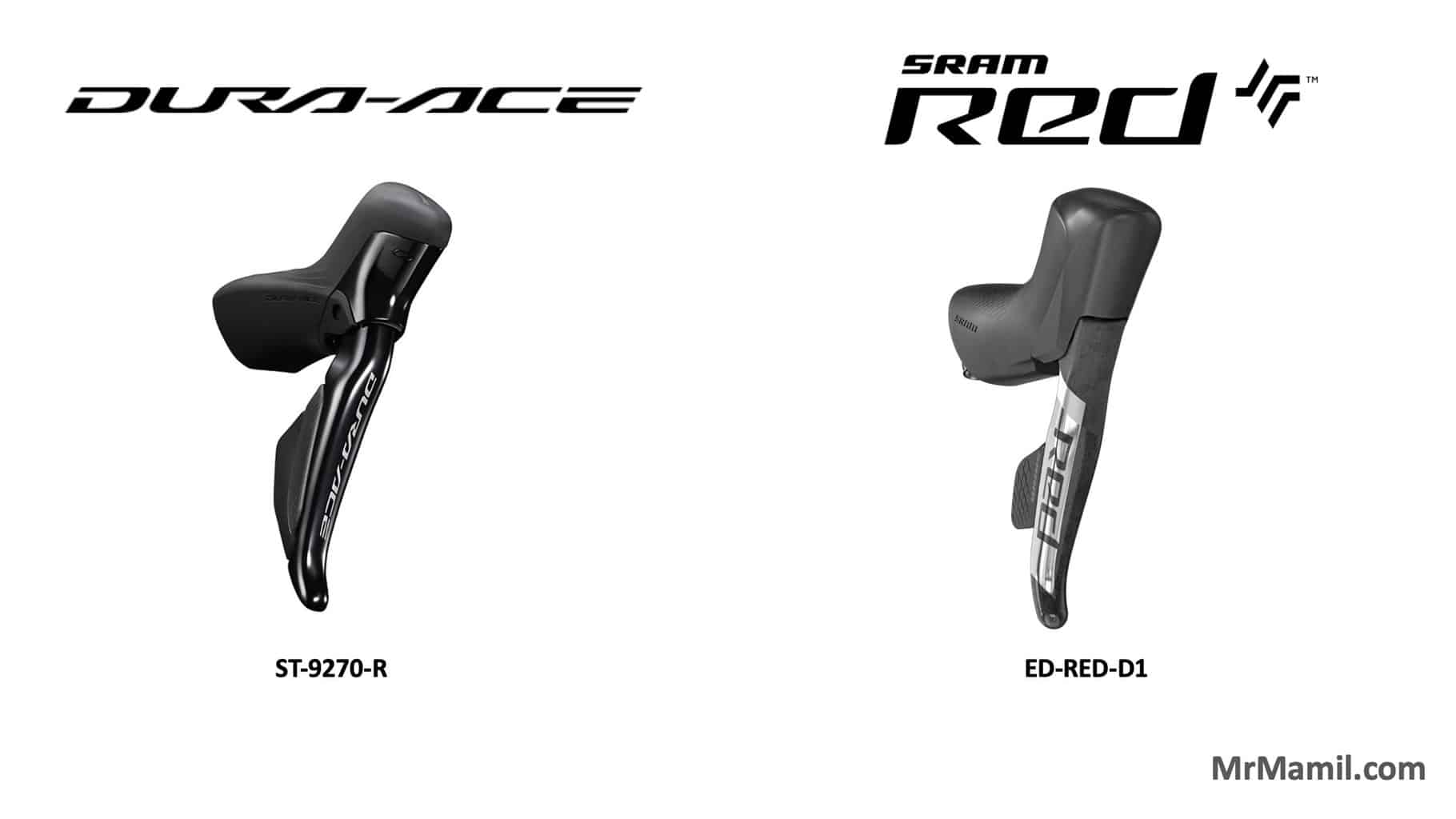
| Comparison | Shimano Dura-Ace Di2 | SRAM Red AXS |
|---|---|---|
| Model no. | ST-R9270-R/L | ED-RED-D1 |
| Disc brake | Available | Available |
| Rim brake | Available | Available |
| Batteries (each lever) | CR1632 | CR2032 |
| Lever material | Carbon | Carbon |
| Hood button | Yes | No |
| Cable ports | 2 | 2 |
| Brake caliper mount | Flat mount | Flat, post mount |
| Brake lever weight (per lever) | 330g | 402g |
| Price (USD) | $1,100 | $1,014 – $1,157 |
| Where to buy | Amazon Competitive Cyclist Wiggle | Amazon Competitive Cyclist Wiggle |
Shimano Dura-Ace brake levers and shifters
Shimano redesigned the Dura-Ace Di2 brake levers and shifters from its predecessor (R9170).
The new design has slightly raised hoods and improved ergonomics for better hand support. The ServoWave technology, already available in GRX (gravel) and XTR/XT (mountain bike) range, is now available on the Dura-Ace.
According to Shimano;
When you pull a ServoWave brake lever, initial pad travel is fast, so little lever movement is needed to bring the pads into contact with the rotor.
The power multiplication factor then increases rapidly at the pad-to-rim contact so more of the lever stroke is used to apply greater braking power with improved control.
Shimano ServoWave Technology
Compared to the previous generation R9170, the brakes are the biggest improvement. The brake calipers have a 10% wider brake pad clearance that minimizes the chances of a brake rub.
Each brake lever uses a CR1632 battery which Shimano claims can last 1.5 to 2 years. There are two Di2 cable ports on each brake lever, but they’re not needed if it’s set up as wireless shifting. The ports can be used for a wired setup to connect to a junction box or sprint/climbing shifters.
SRAM Red eTap AXS brake levers and shifters
The SRAM Red AXS brake levers are slightly larger than the Shimano Dura-Ace Di2 levers. This has been the case since its predecessor (11s SRAM Red HRD), as SRAM uses a larger hydraulic master cylinder in the hoods.
Each brake lever uses a CR2032 battery which SRAM claims lasts up to 2 years, depending on the shifting frequency. The battery levels can be checked using the LED indicator via the SRAM AXS app.
Similarities in brake levers and shifters
- Wireless shifting. Shimano Dura-Ace Di2 can be configured wireless (default option) or wired (requires additional cables and Junction A). SRAM Red AXS is a fully wireless setup.
- Lever reach adjustment refers to the distance between the drop bar grip to the brake lever.
- Free stroke adjustment is available for both. This refers to the point in the brake levers’ stroke where the brake pads come into contact with the rotor. SRAM refers to this as the Contact Point Adjustment.
- Carbon fiber brake levers to reduce overall weight. The shifter buttons are made out of plastic.
- Coin battery powered. Shimano Dura-Ace Di2 uses one CR1632 battery, while SRAM Red AXS uses a CR2032 battery, per lever.
- Cable ports. Shimano Dura-Ace Di2 lever has two cable ports for a wired setup and sprint shifters. The SRAM Red AXS has a single cable port for Blips (SRAM).
Differences in brake levers and shifters
- Shift buttons. There are three buttons on the Shimano Dura-Ace Di2 levers compared to one on the SRAM Red AXS. The buttons are fully customizable according to your preferences through the Shimano E-Tube App or SRAM AXS mobile app.
- Weight. Shimano Dura-Ace is around 70g lighter (levers, brake caliper, brake hose).
- Button feel. The Shimano shift buttons feel lighter compared to the more tactile SRAM buttons. SRAM has a bigger button surface which is an advantage when wearing thicker gloves during the winter.
Rear derailleurs
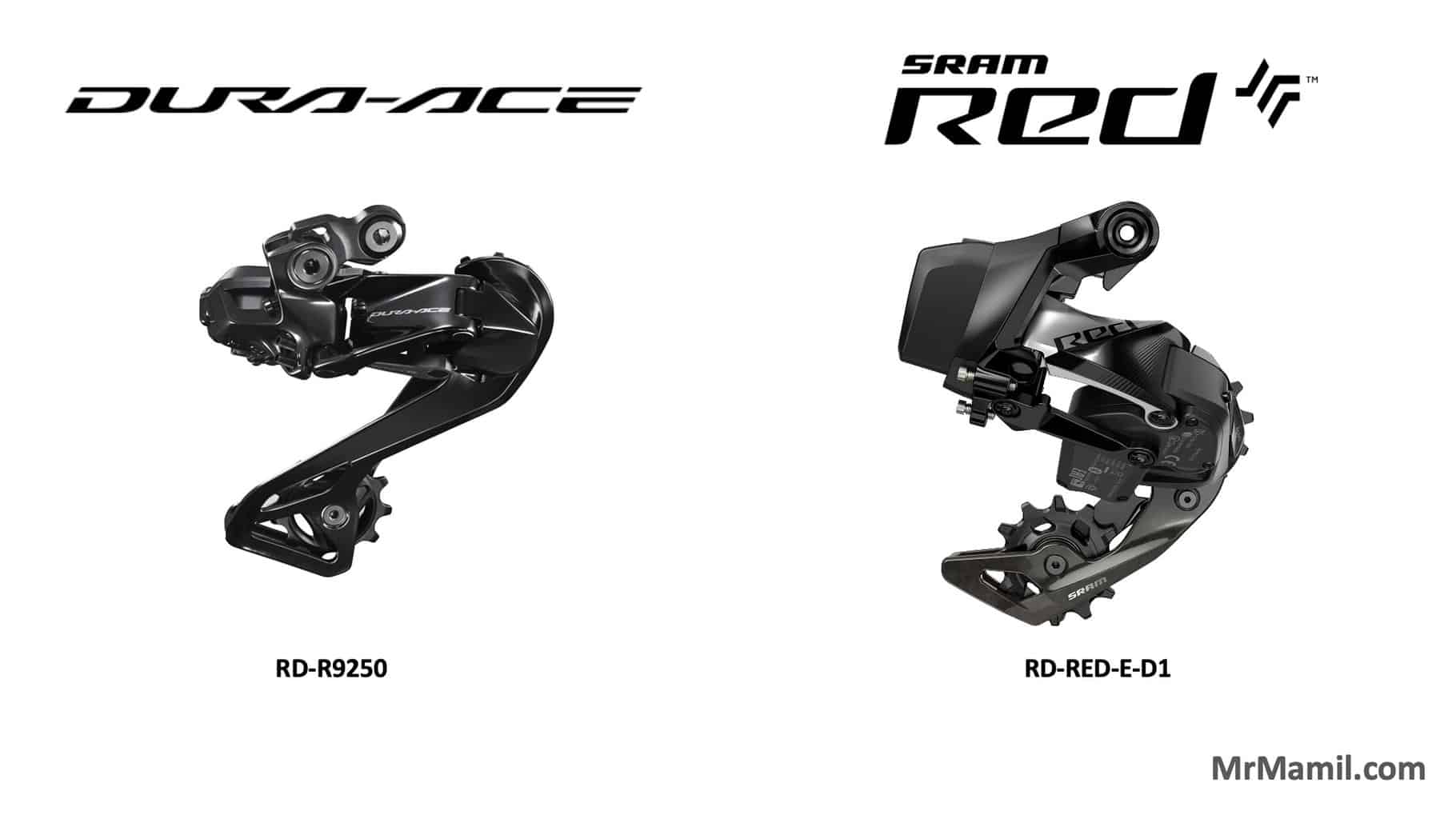
| Comparison | Shimano Dura-Ace Di2 | SRAM Red AXS |
|---|---|---|
| Model no. | RD-R9250 | RD-RED-E-D1 |
| Rear derailleur weight | 217g | 303g |
| Max. cog size | 34T | 33T, 36T |
| Cage material | Carbon | Carbon |
| Pulley bearings | Steel | Ceramic |
| Price (USD) | $815 | $1,313 |
| Where to buy | Amazon Competitive Cyclist Wiggle | Amazon Competitive Cyclist |
Shimano Dura-Ace rear derailleur
The Shimano Dura-Ace Di2 rear derailleur uses the Shimano Shadow design, which places the rear derailleur in a low-profile design. It provides aerodynamic benefits and lessens the chances of damage in a crash.
The rear derailleur is now the hub of the Di2 system, housing the charging port, LED indicators, and function button for shift configurations. The derailleur cage supports cassette sizes up to 34T.
SRAM Red eTap AXS rear derailleur
The SRAM Red AXS rear derailleur is larger as it needs to accommodate the battery. Two rear derailleur variants are available;
- Short cage (max 33T cassette)
- Medium cage (max 36T cassette)
Be sure to pick the correct variant depending on your cassette size.
SRAM uses its Orbit technology (only available in Red and Force AXS) to keep the chain under tension and ensure smooth shifting. According to SRAM;
Orbit technology is an innovative new form of derailleur motion control. It utilizes silicon fluid as part of an elegant and ultra-lightweight damper system.
Compared to a standard friction clutch system, Orbit technology places no additional resistance on the rear derailleur’s spring when under slow or light movement. This means easier shifting and rear wheel removal. And while riding the fluid damper reduces chain bounce.
SRAM’s Orbit Technology
Similarities in rear derailleurs
- Long cage. The rear derailleurs are long cages with a maximum cog size of 34T (Shimano) and 36T (SRAM).
- Cage material. The rear derailleur cages are made from aluminum.
Differences in rear derailleurs
- 1X compatibility is supported by the SRAM Red AXS.
- Weight. The SRAM Red AXS rear derailleur is significantly heavier (+86g) than the Shimano Dura-Ace Di2. This is partly due to the SRAM battery, which weighs 26g alone.
- Ceramic bearings. SRAM Red AXS rear derailleur uses ceramic pulley bearings compared to steel bearings in the Dura-Ace.
More reading : How to Get the Most Out of Shimano Di2 Features
Front derailleurs
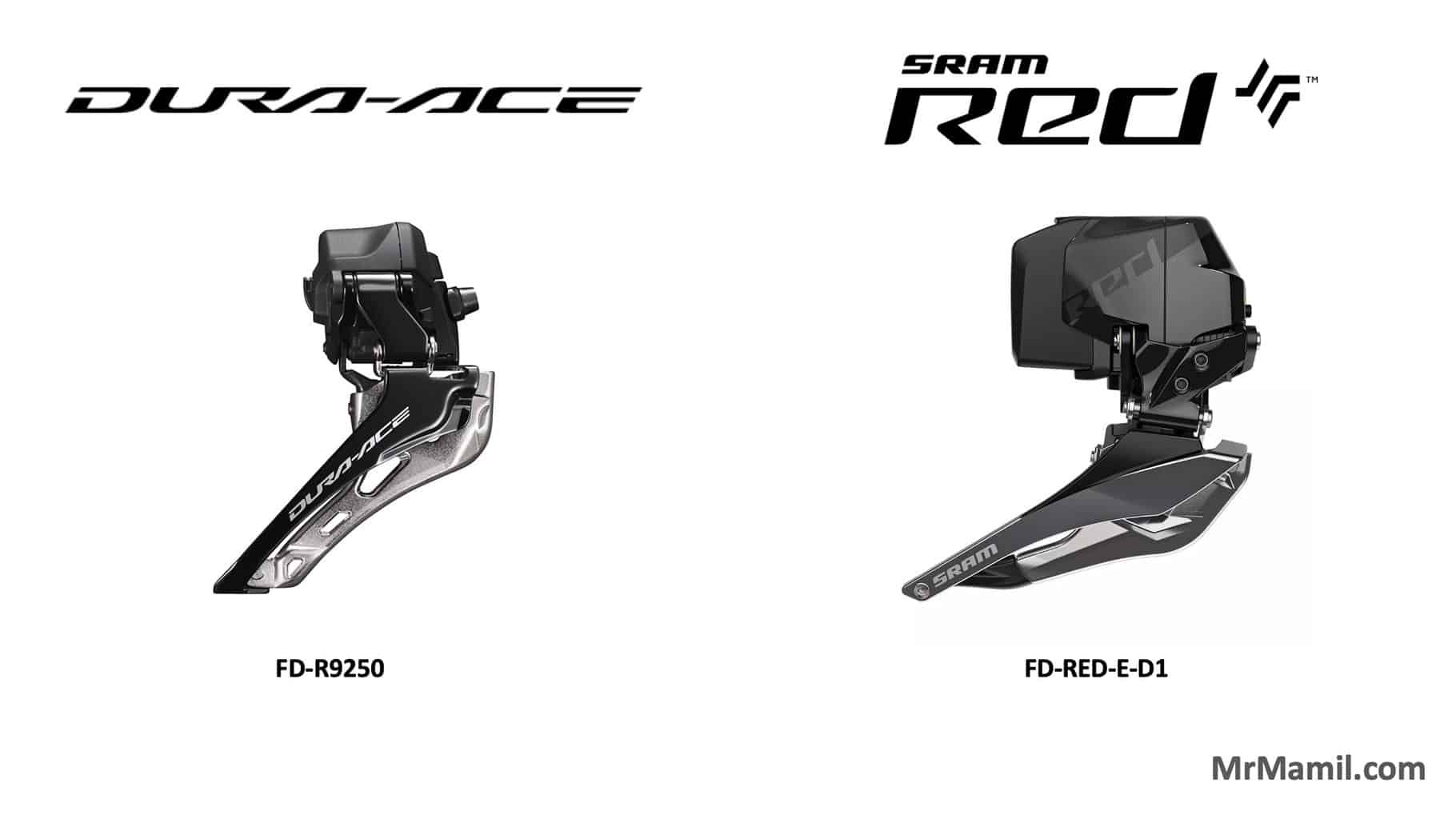
| Comparison | Shimano Dura-Ace Di2 | SRAM Red AXS |
|---|---|---|
| Model no. | FD-R9250 | FD-RED-E-D1 |
| Front derailleur weight | 95g | 170g |
| Price (USD) | $450 | $739 |
| Amazon Competitive Cyclist Wiggle | Competitive Cyclist Wiggle | Amazon Competitive Cyclist |
Shimano has completely redesigned the Dura-Ace Di2 front derailleur to be lower profile and slimmer than its predecessor (R9170).
The SRAM Red AXS front derailleur is bigger as it needs to accommodate the battery. It’s heavier (+75g) than the Shimano Dura-Ace Di2. This is partly due to the battery, which weighs 26g.
Cranksets
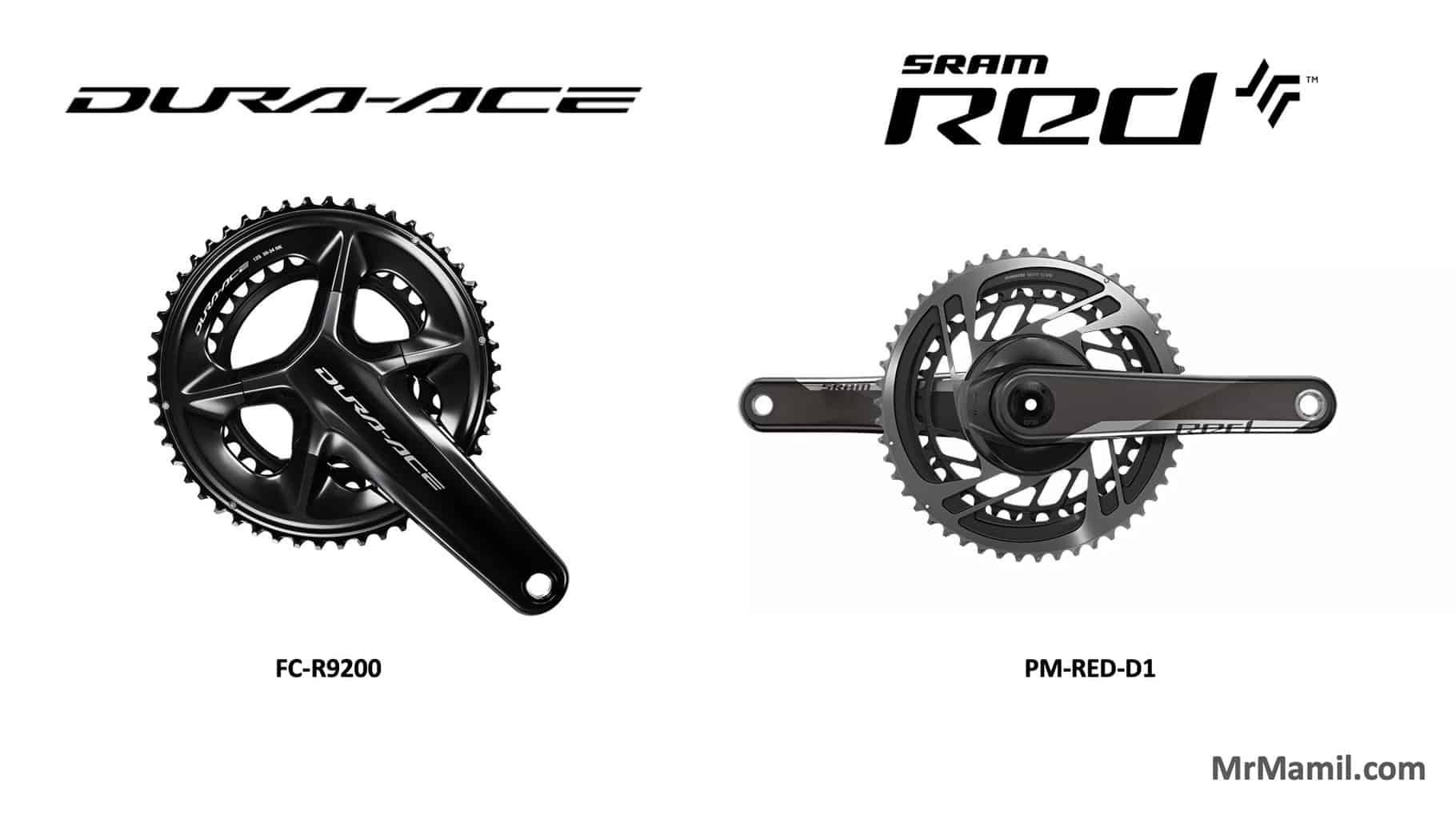
| Comparison | Shimano Dura-Ace Di2 | SRAM Red AXS |
|---|---|---|
| Model no. | FC-R9200 | PM-RED-D1 |
| Chainring options | 50-34T, 52-36T, 54-40T | 46/33T, 48/35T, 50/37T |
| BCD | 110mm | Direct mount |
| Crankarm material | Aluminum | Carbon |
| Crankarm lengths | 160, 165, 170, 172.5, 175, 177.5mm | 165, 167.5, 170, 172.5, 175, 177.5mm |
| Axle diameter | 24mm | 29mm |
| Chainline | 44.5mm | 45mm |
| Powermeter | Optional | Yes |
| Crankset weight | 685g (50/34) | 630g (50/37T) |
| Price (USD) | $625 | $1,715 – $2,219 |
| Where to buy | Amazon Competitive Cyclist | Amazon Competitive Cyclist Wiggle |
Shimano Dura-Ace cranksets
Shimano introduced a new front chainring combination with the 12-speed Dura-Ace; 50/34T (compact), semi-compact (52/36T), and 54/40T. There is no longer a 53/39T (standard) chainring with the Dura-Ace 12s crankset.
According to Shimano, there are many requests from the procyclists for the 54/40T combination as the races are getting faster every year.
The Shimano 11s chainrings are incompatible with the 12s crankset, although they have the same BCD. The difference lies in the placement of the 4 arms. The Dura-Ace 12s crankarm is available from 160mm to 177.5mm in length.
SRAM Red AXS cranksets
SRAM employs the X-Range Gearing for all its 12s groupsets. The SRAM Red AXS cranksets are available in 46/33T, 48/35T, and 50/37T combinations. The 50/37T is only available in Red AXS, not Force and Rival AXS.
The SRAM Red AXS crankset includes a power meter by default. The chainrings and power meter are a 1-piece design and are direct-mounted to the crankarms using an 8-bolt design. It saves weight; the downside is that the power meter needs to be replaced with the chainrings when worn.
Differences in cranksets
- Chainring combinations. The Shimano Dura-Ace Di2 is available in 50/34T, 52-36T, and 54/40T. The chainring sizes for SRAM Red AXS are slightly smaller at 46/33T, 48/35T, and 50/37T.
- BCD. Shimano uses a 110mm BCD, and SRAM uses a Direct Mount chainring to lower the overall weight.
- Power meter is the default option for SRAM Red AXS. For Shimano, a new crankset is required (FC-R9200P).
- Bottom bracket compatibility. Shimano crankset uses a 24mm steel axle. SRAM uses a 29mm steel axle and is only compatible with SRAM DUB bottom brackets.
- Crankarm material. Shimano Dura-Ace crankarms are made of aluminum compared to carbon fiber for SRAM Red AXS.
- Crankarm lengths. Shimano crankarms are available in 160, 165, 170, 172.5, 175, and 177.5mm lengths. SRAM is available from 165 to 177.5mm, in 2.5mm increments.
More reading : How to Decide Between Compact vs Standard Crankset
Gear ratios
The gear ratios are among the biggest differences between the Shimano and SRAM 12-speed groupset.
SRAM’s X-Range Gearing has a wider gearing range and tighter jumps between cogs than Shimano. This makes maintaining the same cadence more versatile and easier after a gear shift.
- High gear. SRAM has the highest gear ratio at 5.0, using a 50/37T front chainring and 10T rear cog, followed by Shimano (4.91) with a 54/40T front chainring and an 11T rear cog.
- Low gear. SRAM and Shimano have the same lowest gear ratio at 1.0. SRAM uses a 46/33T front chainring and 33T rear cog, and Shimano uses a 50/34T front chainring and 34T rear cog.
The table below shows the possible gearing setup for Shimano Dura-Ace Di2 vs SRAM Red AXS.
| Front chainring | Rear cog | Shimano gear ratio | SRAM gear ratio |
|---|---|---|---|
| 46 | 10 | 4.60 | |
| 48 | 10 | 4.80 | |
| 50 | 10 | 5.00 | |
| 33 | 26 | 1.27 | |
| 35 | 26 | 1.35 | |
| 37 | 26 | 1.42 | |
| 33 | 28 | 1.18 | |
| 35 | 28 | 1.25 | |
| 37 | 28 | 1.32 | |
| 33 | 33 | 1.00 | |
| 35 | 33 | 1.06 | |
| 37 | 33 | 1.12 | |
| 50 | 11 | 4.55 | |
| 52 | 11 | 4.73 | |
| 54 | 11 | 4.91 | |
| 34 | 30 | 1.13 | |
| 36 | 30 | 1.20 | |
| 40 | 30 | 1.33 | |
| 34 | 34 | 1.00 | |
| 36 | 34 | 1.06 | |
| 40 | 34 | 1.18 |
Groupsets comparison
12-speed chains
| Comparison | Shimano Dura-Ace Di2 | SRAM Red AXS |
|---|---|---|
| Model | CN-M9100 | CN-RED-D1 |
| Links | 116, 126 | 114, 120 |
| Chain weight | 249g | 249g |
| Material | Steel | Steel |
| Outer plates finish | Sil-tec | Nickel |
| Inner plates finish | Sil-tec | Chrome |
| Pin design | Hollow | Hollow |
| Price (USD) | $69 | $75 |
| Where to buy | Competitive Cyclist | Amazon |
The Shimano Dura-Ace and SRAM Red AXS
Shimano Dura-Ace 12-speed chains
The Shimano Dura-Ace chains are available in 116 and 126 links. The chains are made from steel and have a hollow pin design, have a Sil-tec coating on the inner and outer plates.
Sil-Tec is an advanced plating process using embedded fluorine particles for the chain to run smoother and decrease the wear rate.
SRAM Red AXS 12-speed chains
The SRAM Red AXS chains are available in 114 and 120 links. They have a nickel outer and chrome inner plate finish. It uses a Flattop design which, according to SRAM, is quieter and more durable. According to SRAM;
To gain a wider gear range with smaller gearing steps, the chain has to get narrower. With Flattop, we’ve added material on the flat side of the chain plates to strengthen every link.
Flattop chains feature longer wearing large diameter rollers that help deliver the same drivetrain efficiency as our 11-speed drivetrains. All of these technologies together have enabled us to engineer a narrower 12-speed chain that lasts 36% longer than our 11-speed chains.
SRAM
More reading : When to Replace A Bike Chain?
12-speed cassettes
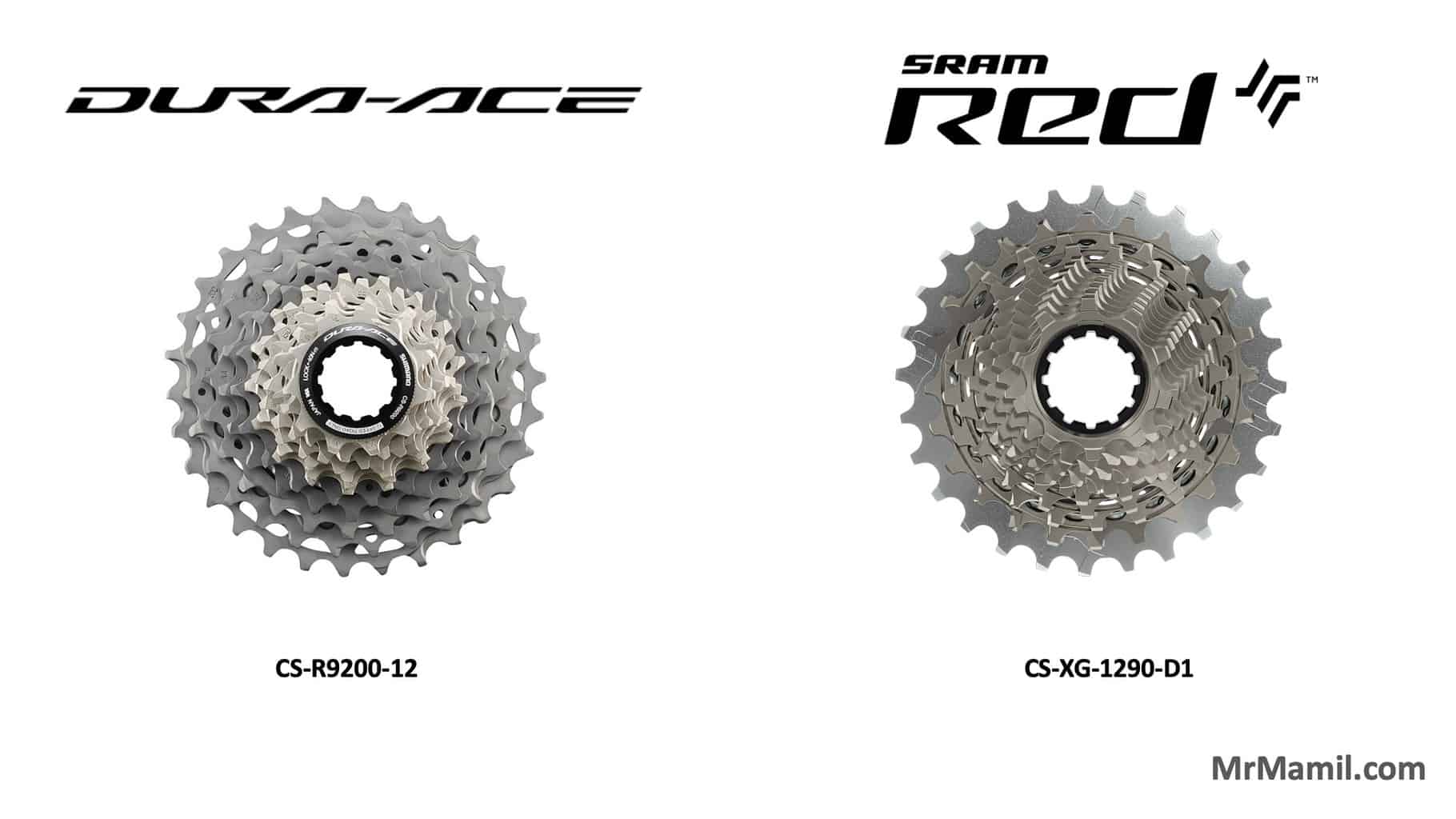
| Comparison | Shimano Dura-Ace Di2 | SRAM Red AXS |
|---|---|---|
| Model | CS-R9200-12 | CS-XG-1290-D1 |
| Cassette size and weight | 11-30T (223g) 11-34T (253g) | 10-26T (175g) 10-28T (183g) 10-33T (211g) |
| Price | $360 | $377 |
| Where to buy | Amazon Competitive Cyclist Wiggle | Amazon Competitive Cyclist Wiggle |
The Shimano Dura-Ace 12-speed cassette is available in two sizes; 11-30T and 11-34T. It uses the newer Hyperglide+ (HG+) technology, where the tooth profile matches the chain for faster shifting, both up and down the cassette, especially under load.
The SRAM Red AXS cassette is available in four sizes; 10-28T, 10-30T, 10-33T, and 10-36T. The cassette is a single block of steel using SRAM’s X-Dome technology to minimize weight.
More reading : Shimano 105 vs Ultegra vs Dura-Ace Cassettes
Disc brake rotors

| Comparison | Shimano Dura-Ace | SRAM Paceline | SRAM Centerline |
|---|---|---|---|
| Model no. | RT-CL900 | RT-PLN-A1 | RT-CLX-R-A1 |
| Mount type | Centerlock | Centerlock, 6-bolt | Centerlock, 6-bolt |
| Rotor weight (140mm) | 95g | 137g | 108g |
| Rotor weight (160mm) | 113g | 157g | 135g |
| Price (USD) | $86 | $54 | $113 |
| Where to buy | Amazon Competitive Cyclist Wiggle | Amazon Wiggle | Amazon Competitive Cyclist Wiggle |
Shimano Dura-Ace and SRAM Red rotors are available in 140mm and 160mm sizes.
Shimano rotors are only Centerlock. Shimano used the same brake rotors from their mountain bike lineup, the RT-MT900, when launching the 12-speed Dura-Ace groupset in September 2021. In June 2022, Shimano introduced a new disc rotor, the RT-CL900, as part of the Dura-Ace R9200 series.
The default rotor choice for SRAM is the Centerline, available in Centerlock and 6-bolt design. Alternatively, a cheaper but heavier option is the SRAM Paceline rotors.
More reading : Centerlock vs 6-bolt Disc Brake Rotors
Disc brake pads
The Shimano Dura-Ace comes with Shimano’s latest, fifth-generation organic (resin) brake pads, L05A-RF. Older models such as L03A-RF (organic), L02A-RF (organic), or L04C-MF (metallic) are compatible with the disc brake calipers as they all have the same shape.
The SRAM Red AXS comes with an organic brake pad with steel plating. There are other alternatives, such as organic compounds with aluminum plating or metallic compounds with steel plating.
More reading : Resin vs Metal Disc Brake Pads Comparison
Electronic shifting batteries
Shimano introduced a new battery (BT-DN300) for the 12-speed wireless groupsets. There are three ports on the battery, with only two needed for a wireless setup. The third port will be used for a wired setup to connect the shifters via a junction box.
It weighs 52g and has a capacity of 500 mAh, takes 1.5 to 2 hours for a full charge, and lasts for around 2,500 to 3,000km per charge.
SRAM uses one battery each for the front and rear derailleurs. Each battery weighs 24g and can last up to 1,000km per charge for the rear battery, which sees more usage.
The advantage of SRAM is that the batteries are easily interchangeable should any battery run flat. It takes around 60 minutes for a full charge.
More reading : How to Check Shimano Di2 Battery Levels

Bernard Lu has 7+ years of experience working in a bicycle shop, overseeing the retail and workshop operations. He’s a qualified bicycle mechanic who understands a cyclist’s needs and speaks the same cycling lingo.
If you meet him at the cafe, he will happily talk to you for hours about all the intricacies of bikes and cycling tech. Just buy him a coffee next time you see him.